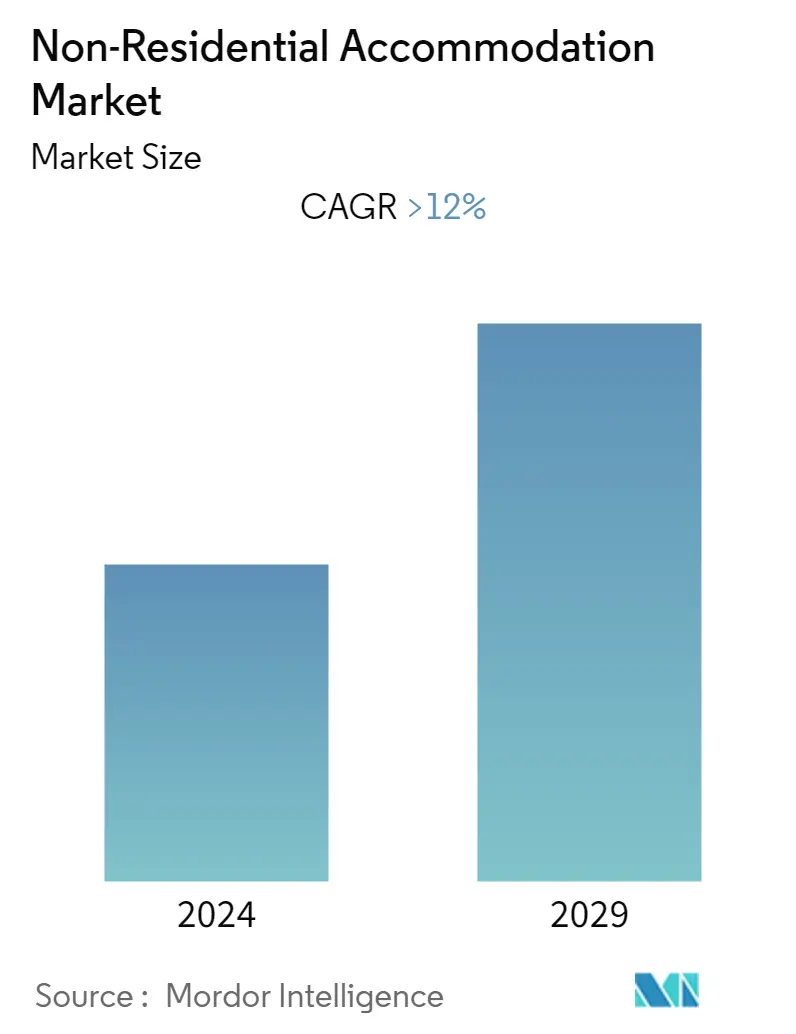Market Size of Non-Residential Accommodation Industry

| Study Period | 2019 - 2029 |
| Base Year For Estimation | 2023 |
| CAGR | > 12.00 % |
| Fastest Growing Market | North America |
| Largest Market | Asia-Pacific |
| Market Concentration | High |
Major Players
*Disclaimer: Major Players sorted in no particular order |
Non-Residential Accommodation Market Analysis
The Non-Residential Accommodation Market is expected to grow at a CAGR greater than 12% during the forecasted period.
The outbreak of the Covid-19 pandemic had a significant impact on the global non-residential accommodation market. The travel and tourism industry, a major market driver, was severely impacted by the pandemic as countries worldwide implemented travel restrictions and lockdowns to curb the spread of the virus. The hotel industry, in particular, was severely affected by the pandemic, with many hotels experiencing significant declines in occupancy rates and revenues. The pandemic also accelerated technology adoption in the non-residential accommodation industry. Hotels and other accommodation providers implement digital solutions such as mobile check-ins and keyless room access to minimize contact between guests and staff.
The market is driven by increased business travel, tourism, and globalization. The rise of the middle class in emerging economies also contributed to the growth of the non-residential accommodation market, as more people contains the financial means to travel and stay in hotels or other forms of accommodation. The market is highly competitive, with many players operating at various levels of the value chain, from budget to luxury accommodation. Overall, the global non-residential accommodation market is expected to grow over the long term, driven by economic growth, urbanization, and increasing global travel. However, the market's recovery from the pandemic's impact is expected to be gradual, with growth rates varying by region and accommodation type.
Non-Residential Accommodation Industry Segmentation
Non-residential accommodation refers to real estate that are not a dwelling, such as a commercial or industrial space, a place of worship, a hotel, a hospital, a school, or a facility owned by the government. Non-residential accommodations include small businesses, commercial agriculture buildings, industrial buildings, and warehouses.
The Non-Residential Accommodation Market is segmented by type (hotels, motels, resorts, vacation rentals, and others), end user (leisure travelers, business travelers, and group travelers), distribution channels (hotel websites, Online Travel Agencies (OTA), Travel Management Companies (TMCs), and corporate travel agents), and geography (North America, Europe, Asia Pacific, South America, and the Middle East). The report offers market size and values in (USD million) during the forecast years for the above segments.
| By Type | |
| Hotels | |
| Motels | |
| Resorts | |
| Vacation Rentals | |
| Others |
| By End User | |
| Leisure Travelers | |
| Business Travelers | |
| Group Travelers |
| By Distribution Channels | |
| Hotel Websites | |
| Online Travel Agencies (OTA) | |
| Travel Management Companies (TMCs) | |
| Corporate Travel Agents |
| By Geography | |
| North America | |
| Europe | |
| Asia-Pacific | |
| South America | |
| Middle East |
Non-Residential Accommodation Market Size Summary
The non-residential accommodation market is poised for significant growth, driven by factors such as increased business travel, tourism, and globalization. The rise of the middle class in emerging economies has further fueled this expansion, as more individuals gain the financial means to travel and stay in various forms of accommodation. The market is characterized by intense competition, with numerous players operating across the value chain, from budget to luxury offerings. Despite the challenges posed by the Covid-19 pandemic, which severely impacted the travel and tourism sector, the market is expected to recover gradually. The pandemic also accelerated the adoption of technology within the industry, with accommodation providers implementing digital solutions like mobile check-ins and keyless room access to enhance guest experiences and improve operational efficiency.
Technological advancements continue to shape the non-residential accommodation market, with providers increasingly offering technology-driven services such as digital concierge services and in-room smart technology. These innovations aim to enhance guest experiences and streamline operations, contributing to the market's growth. The popularity of vacation rentals, facilitated by platforms like Airbnb and VRBO, has introduced new competition for traditional hotels, prompting them to offer more unique and localized experiences. The sharing economy's acceptance has further bolstered the demand for vacation rentals, which provide travelers with authentic, flexible, and cost-effective alternatives to traditional accommodations. The market remains relatively consolidated, with major players like Marriott International, Hilton Worldwide Holdings, and InterContinental Hotels Group dominating the landscape, continuously expanding their offerings to capture a broader audience.
Non-Residential Accommodation Market Size - Table of Contents
-
1. MARKET DYNAMICS AND INSIGHTS
-
1.1 Market Overview
-
1.2 Market Drivers
-
1.3 Market Restraints
-
1.4 Industry Value Chain Analysis
-
1.5 Industry Attractiveness - Porter's Five Forces Analysis
-
1.5.1 Bargaining Power of Suppliers
-
1.5.2 Bargaining Power of Buyers
-
1.5.3 Threat of New Entrants
-
1.5.4 Threat of Substitutes
-
1.5.5 Intensity of Competitive Rivalry
-
-
1.6 Insights on Technology Innovations in the Market
-
1.7 Impact of COVID-19 on the Market
-
-
2. MARKET SEGMENTATION
-
2.1 By Type
-
2.1.1 Hotels
-
2.1.2 Motels
-
2.1.3 Resorts
-
2.1.4 Vacation Rentals
-
2.1.5 Others
-
-
2.2 By End User
-
2.2.1 Leisure Travelers
-
2.2.2 Business Travelers
-
2.2.3 Group Travelers
-
-
2.3 By Distribution Channels
-
2.3.1 Hotel Websites
-
2.3.2 Online Travel Agencies (OTA)
-
2.3.3 Travel Management Companies (TMCs)
-
2.3.4 Corporate Travel Agents
-
-
2.4 By Geography
-
2.4.1 North America
-
2.4.2 Europe
-
2.4.3 Asia-Pacific
-
2.4.4 South America
-
2.4.5 Middle East
-
-
Non-Residential Accommodation Market Size FAQs
What is the current Non-Residential Accommodation Market size?
The Non-Residential Accommodation Market is projected to register a CAGR of greater than 12% during the forecast period (2024-2029)
Who are the key players in Non-Residential Accommodation Market?
Marriott International, Hilton Worldwide Holdings, InterContinental Hotels Group, AccorHotels and MGM Resorts International are the major companies operating in the Non-Residential Accommodation Market.

